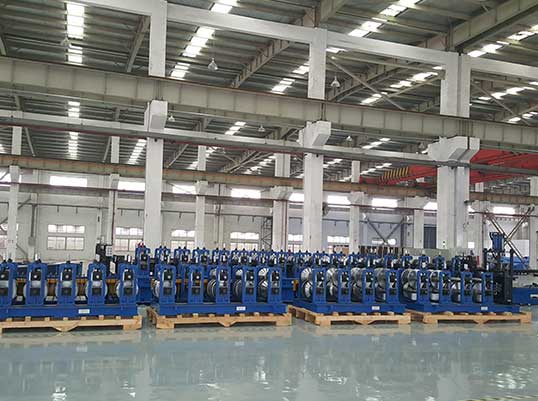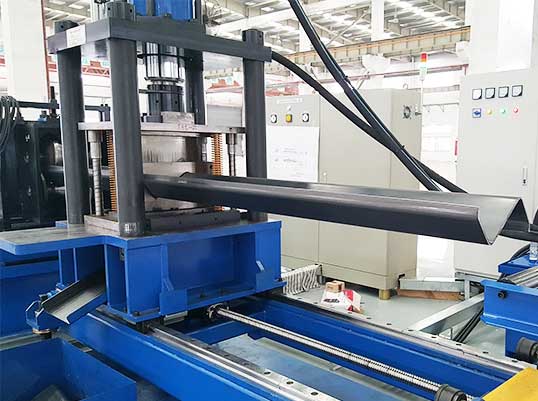Navigation Menu
Contact Us
- Email:
- info@wxavatar.com
- Address:
- Yurong Village, Yuqi Street, Huishan District, Wuxi, China.
Release Date:Mar 19, 2025 Visit:52 Source:Roll Forming Machine Factory
The process flow of a solar bracket forming machine (typically a roll forming machine) involves a series of sequential steps to transform raw metal coils into finished solar racking components. Here's a detailed breakdown of the typical process flow:
1.Material Preparation
Raw Material Loading: Metal coils (usually galvanized steel, aluminum, or stainless steel) are loaded onto a decoiler or uncoiler. These materials are chosen for their strength, corrosion resistance, and lightweight properties.
Material Selection: Thickness and alloy type are selected based on the design requirements (e.g., load-bearing capacity, environmental conditions).
2. Feeding & Straightening
Uncoiling: The metal strip is fed from the decoiler into the machine.
Leveling/Straightening: The material passes through a leveling unit to remove any curls, twists, or deformities from the coil, ensuring flatness and uniformity before forming.
3. Roll Forming
Progressive Shaping: The straightened metal strip enters the roll forming mill, where a series of roller dies (arranged in pairs) incrementally bend and shape the metal into the desired profile (e.g., C-channel, U-channel, or custom solar bracket shapes).
Each roller station performs a small deformation until the final cross-sectional geometry is achieved.
Common profiles include rails, clamps, legs, or purlins for mounting solar panels.

4. Punching/Notching (Optional)
In-Line Hole Punching: If required, holes or slots are punched into the profile during or after forming (e.g., for bolts, grounding, or panel attachments). This is done using integrated punching units synchronized with the roll forming process.
Notching/Cutting: Features like notches or cutouts may be added for component assembly.
5. Cutting to Length
Flying Cut-Off: Once the profile is fully formed, a flying shear or hydraulic cutter cuts the continuous strip into predetermined lengths. The cutting mechanism moves with the material to ensure precision without stopping the line.
6. Post-Processing
Bending/End Forming: Additional bends or end shapes (e.g., flanges) may be added using press brakes or secondary forming tools.
Surface Treatment: Corrosion-resistant coatings (e.g., powder coating, anodizing) may be applied if not pre-coated. Galvanized steel often skips this step.
Embossing/Stamping: Part numbers, logos, or identifiers can be stamped onto the brackets.
7. Quality Control
Dimensional Checks: Automated sensors or manual inspections verify critical dimensions (e.g., hole alignment, profile geometry).
Load Testing: Sample brackets may undergo stress tests to ensure they meet structural requirements (e.g., wind/snow load ratings).
8. Stacking & Packaging
Finished brackets are automatically stacked, bundled, and packaged for shipping. Protective films or spacers may be added to prevent scratches during transit.
9. Integration with Auxiliary Systems (Optional)
Automation: Advanced lines integrate robotic arms for sorting, palletizing, or direct assembly with other components (e.g., bolts, connectors).
Software Control: CNC systems adjust parameters (e.g., cutting length, punch patterns) based on pre-programmed designs.
Key Advantages of This Process Flow
High Speed: Continuous production enables mass output (e.g., 30–100 meters per minute).
Precision: Tight tolerances (±0.5 mm) ensure consistency for easy on-site assembly.
Minimal Waste: Efficient material use reduces scrap.
Customization: Quick die changes allow flexibility for different bracket designs.

Example Solar Bracket Profiles
Mounting Rails: Long, rigid profiles to hold solar panels.
Clamps/End Caps: Components to secure panels to rails.
Ground-Mount Legs: Vertical supports for fixed or tracking systems.
Roof Hooks: Brackets for attaching rails to rooftop structures.
Conclusion
The solar bracket forming machine’s process flow is optimized for speed, precision, and scalability, making it ideal for producing durable, lightweight, and cost-effective racking components. This efficiency is critical to meeting the growing global demand for solar energy infrastructure.